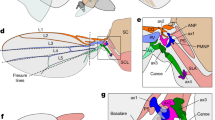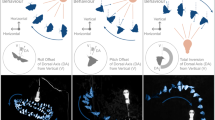Abstract
DARWIN1 described the sound made by the forewings of the nymphalid Ageronia feronia as a click of a spring catch on a toothed wheel. Descriptions of the sounds produced by the Agarasidae, which have similarly modified forewings, have repeatedly invoked the rubbing of either the antennae or foretibia on the ribbed forewing2,3. Nicholson4 suggested that the production of sound in the whistling moth Hecatesia was percussive, with the knobs of each forewing (castanets) striking each other at the top of the flight stroke. I have confirmed the existence of such a percussive system in two species of Hecatesia. Recordings of H. exultans Walker and H. thyridion Feisthamel from the coastal sand plain of Western Australia revealed two patterns of sound corresponding to the respective flight behaviour of the two species.
This is a preview of subscription content, access via your institution
Access options
Subscribe to this journal
Receive 51 print issues and online access
$199.00 per year
only $3.90 per issue
Buy this article
- Purchase on Springer Link
- Instant access to full article PDF
Prices may be subject to local taxes which are calculated during checkout
Similar content being viewed by others
References
Darwin, C. The Descent of Man and Selection in Relation to Sex (London, 1894).
Edwards, H. Insect Life 2, 11 (1889).
Hampson, S. F. Proc. Zool. Soc., Lond. 188 (1892).
Nicholson, A. R. Trans. R. ent. Soc. C, 20, 13 (1955).
Bailey, W. J. Nature 215, 949–950 (1967).
Bailey, W. J. J. exp. Biol. 52, 495–505 (1970).
Bennet-Clark, H. C. J. exp. Biol. 52, 619–652 (1970).
Author information
Authors and Affiliations
Rights and permissions
About this article
Cite this article
BAILEY, W. Resonant wing systems in the Australian whistling moth Hecatesia (Agarasidae, Lepidoptera). Nature 272, 444–446 (1978). https://doi.org/10.1038/272444a0
Received:
Accepted:
Published:
Issue Date:
DOI: https://doi.org/10.1038/272444a0
This article is cited by
-
Sexual communication in diurnal moths: behaviors and mechanisms
International Journal of Tropical Insect Science (2021)
-
Deaf moths employ acoustic Müllerian mimicry against bats using wingbeat-powered tymbals
Scientific Reports (2019)
-
Moth hearing and sound communication
Journal of Comparative Physiology A (2015)
-
Male courtship ultrasound produced by mesothoracic tymbal organs in the yellow peach moth Conogethes punctiferalis (Lepidoptera: Crambidae)
Applied Entomology and Zoology (2012)
-
Acoustic signaling, territoriality, and mating in whistling moths,Hecatesia thyridion (Agaristidae)
Journal of Insect Behavior (1989)
Comments
By submitting a comment you agree to abide by our Terms and Community Guidelines. If you find something abusive or that does not comply with our terms or guidelines please flag it as inappropriate.



